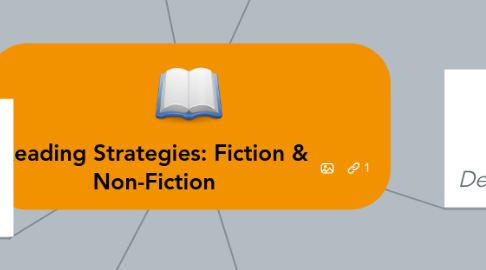
1. Making Inferences
1.1. Read between the lines
1.2. Make interpretations
1.2.1. Access schema
1.2.2. Merge with clues
1.2.3. Write down questions
1.3. Draw conclusions
1.4. Compare and contrast
1.4.1. Questions
1.4.2. Conclusions
2. Visualizing
2.1. Infer meaning
2.1.1. Pose questions with pictures
2.1.2. Check answers through reading
2.2. Create pictures in mind
2.2.1. Increases level of engagement
2.2.2. Attention waves less
2.2.3. Get more out of story
2.3. Non-fiction
2.3.1. Stop
2.3.2. Think About
2.3.3. Understand
3. Questioning
3.1. Before
3.1.1. Concept Map
3.1.2. Knowledge Rating Chart
3.2. During
3.2.1. Stop and Think
3.2.2. Self-Monitor
3.2.3. Apply fix-up strategy
3.3. After
3.3.1. Oral book talks
3.3.2. Panel presentations
3.3.3. Discussions
3.3.3.1. Teacher-led
3.3.3.2. Student-led
4. Determining Importance
4.1. Find the purpose for reading
4.1.1. Fiction
4.1.1.1. Character's Actions
4.1.1.2. Motives
4.1.1.3. Problems/Conflicts
4.1.1.4. Overall theme
4.1.2. Non-fiction
4.1.2.1. Learn information
4.1.2.2. Remember information
4.2. Main Idea
4.2.1. One main idea
4.2.2. More than one main idea
5. Summarizing & Synthesizing
5.1. Summarizing
5.1.1. Merge information with own thinking
5.1.2. Shape it into own thoughts
5.1.3. Retell information
5.1.4. Paraphrase
5.2. Synthesizing
5.2.1. Add information to existing knowledge
5.2.1.1. Develop thinking
5.2.1.2. Learn more
5.2.2. Reader changes thinking
5.2.2.1. Gains new perspective
5.2.2.2. Develops new understanding
6. Activating Background Knowledge
6.1. Access Schema
6.2. Bridge old information to new
6.3. Make Connections
6.3.1. Text to Self
6.3.2. Text to Text
6.3.3. Text to World
